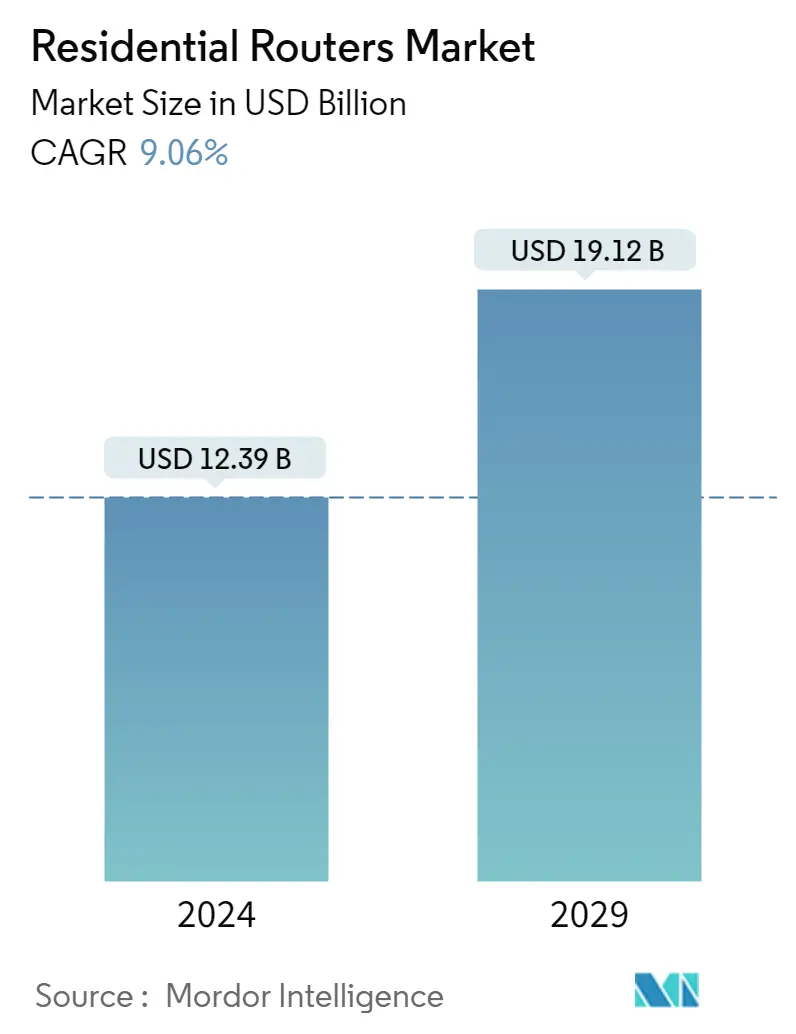Market Size of Residential Routers Industry

| Study Period | 2019 - 2029 |
| Market Size (2024) | USD 12.39 Billion |
| Market Size (2029) | USD 19.12 Billion |
| CAGR (2024 - 2029) | 9.06 % |
| Fastest Growing Market | Asia-Pacific |
| Largest Market | North America |
| Market Concentration | Low |
Major Players
*Disclaimer: Major Players sorted in no particular order |
Residential Router Market Analysis
The Residential Routers Market size is estimated at USD 12.39 billion in 2024, and is expected to reach USD 19.12 billion by 2029, growing at a CAGR of 9.06% during the forecast period (2024-2029).
- The integration of IoT devices into households is heavily reliant on robust internet connections and networks. A smart home can only function seamlessly if all automation devices are properly connected to the internet at the location where they are installed. This is where the router comes into play as it manages internet connectivity within the home. Thus, a router plays a crucial role in ensuring uninterrupted and smooth network functioning.
- In March 2022, Vodafone-Idea launched the Vi MiFi, a pocket-sized 4G router that enables users to connect up to 10 Wi-Fi-enabled devices. This router boasts a high battery capacity of 2700 mAh, which can last for up to 5 hours on a single charge. Additionally, in August 2022, Reliance Jio launched the Jio Wi-Fi Mesh router, which expands network coverage across homes, covering an area of up to 1000 sq ft across a single floor.
- The Covid-19 pandemic led to a significant increase in network traffic, with a 40% surge observed in the first few weeks. As the outbreak spread, traffic patterns shifted from business parks to residential areas, leading to a continued surge in content consumption, gaming, and OTT demand. This highlights the need for efficient home routers.
- It is worth noting that the distance between the router and the device can greatly impact Wi-Fi speed and connection strength. Therefore, it is essential that routers are designed to provide a strong and wide signal to reach all areas of the house. To withstand the competitive market, router manufacturers require constant innovation and technological advancements.
Residential Router Industry Segmentation
A router is a gateway that passes data between one or more local area networks. It is a device that provides Wi-Fi and is typically connected to a modem. The router that is installed in homes to share a single internet connection to multiple devices is a residential router. These internet-connected devices in the home form a local area network (LAN).
The residential routers market is segmented by connectivity type (wired and wireless), standard (802.11b/g/n, 802.11ac, 802.11ax), and geography.
The market sizes and forecasts are provided in terms of value (USD million) for all the above segments.
| Connectivity Type | |
| Wired | |
| Wireless |
| Standard | |
| 802.11b/g/n | |
| 802.11ac | |
| 802.11ax |
| Geography | ||||||
| ||||||
| ||||||
| ||||||
| Latin America | ||||||
| Middle East and Africa |
Residential Routers Market Size Summary
The residential router market is poised for substantial growth, driven by the increasing integration of IoT devices and the demand for robust internet connectivity in smart homes. As households become more reliant on automated devices, the role of routers in managing seamless internet connectivity becomes crucial. This demand is further amplified by the shift in internet traffic patterns observed during the Covid-19 pandemic, which highlighted the necessity for efficient home routers to support increased content consumption and online activities. The market is characterized by rapid technological advancements and innovation, with manufacturers like Vodafone-Idea and Reliance Jio introducing products that enhance network coverage and connectivity. The competitive landscape is marked by the presence of key players such as D-Link Corporation, Netgear Inc., and Linksys Group, who are continually investing in developing advanced hardware and software solutions to meet evolving consumer needs.
The expanding accessibility and affordability of the internet, particularly through wireless technologies, have made Wi-Fi routers a staple in households, facilitating improved productivity and convenience. Initiatives like Qualcomm's 5G Smart Schools program and Cox Private Networks' Fixed Wireless trials aim to bridge the digital divide, especially in rural areas, by providing high-speed internet access. The residential router market is further influenced by the proliferation of 5G technology, which is expected to dominate the wireless services sector, particularly in North America. This growth is supported by strategic partnerships and innovations, such as MediaTek's collaboration with Invendis to launch 5G routers in India and Siemens' introduction of 5G industrial routers. These developments underscore the market's potential for continued expansion as new technologies and solutions are introduced to enhance connectivity and network performance.
Residential Routers Market Size - Table of Contents
-
1. MARKET DYNAMICS
-
1.1 Market Overview
-
1.2 Industry Attractiveness - Porter's Five Forces Analysis
-
1.2.1 Threat of New Entrants
-
1.2.2 Bargaining Power of Buyers
-
1.2.3 Bargaining Power of Suppliers
-
1.2.4 Threat of Substitutes
-
1.2.5 Intensity of Competitive Rivalry
-
-
1.3 Impact of COVID-19 on the Market
-
1.4 Market Drivers
-
1.4.1 Increasing Demand of Connected Devices and Proliferating Smart Homes Market
-
1.4.2 Growth in IP Traffic
-
-
1.5 Market Challenges
-
1.5.1 Increasing Threat of Security Breaches
-
-
-
2. MARKET SEGMENTATION
-
2.1 Connectivity Type
-
2.1.1 Wired
-
2.1.2 Wireless
-
-
2.2 Standard
-
2.2.1 802.11b/g/n
-
2.2.2 802.11ac
-
2.2.3 802.11ax
-
-
2.3 Geography
-
2.3.1 North America
-
2.3.1.1 United States
-
2.3.1.2 Canada
-
-
2.3.2 Europe
-
2.3.2.1 United Kingdom
-
2.3.2.2 Germany
-
2.3.2.3 Rest of Europe
-
-
2.3.3 Asia-Pacific
-
2.3.3.1 China
-
2.3.3.2 Japan
-
2.3.3.3 India
-
2.3.3.4 Rest of Asia-Pacific
-
-
2.3.4 Latin America
-
2.3.5 Middle East and Africa
-
-
Residential Routers Market Size FAQs
How big is the Residential Routers Market?
The Residential Routers Market size is expected to reach USD 12.39 billion in 2024 and grow at a CAGR of 9.06% to reach USD 19.12 billion by 2029.
What is the current Residential Routers Market size?
In 2024, the Residential Routers Market size is expected to reach USD 12.39 billion.

